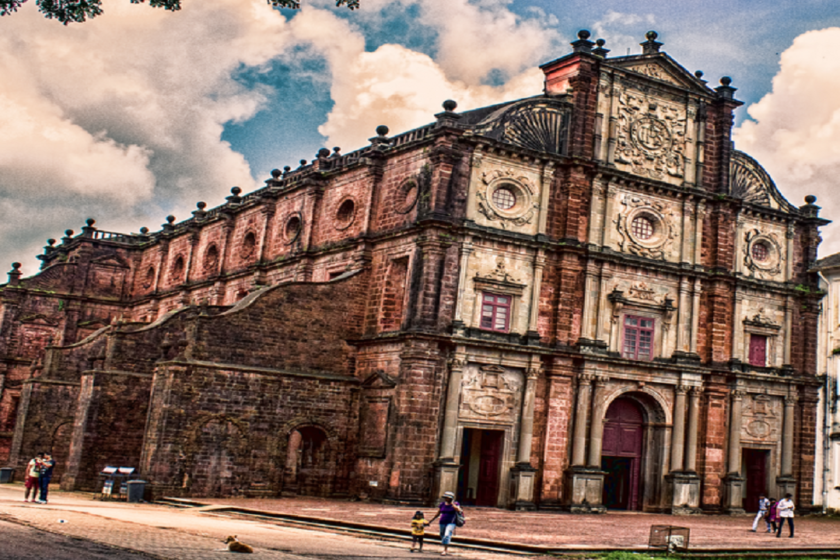Destruction of Hindu temples in Goa by Christian fanatics
Article by @OGSaffron
While the destruction of Hindu temples by Muslim invaders gets most of the discussion spotlight, and understandably so, an exposition of anti-Hindu iconoclasm by anti-Dharmic forces would remain incomplete if it did not mention the Christian iconoclastic campaigns against Hindu society. Therefore, this brief essay correctly positions Hindu-Christian encounters as not the intercultural meeting of two distributed groups but instead a story of Hindu survival against the crusading spirit of anti-idolatry.
With that in mind, the tragic story of Goa resembles the religious nature characteristic of the destruction of Hindu temples by Muslim invaders. Indeed, and much to the chagrin of secular revisionists of Indian history, the story of Hindu survival in Goa against Christian conquistadores is rooted in the intransigence of proselytism, even though secularists would have laymen believe it to be originating from Brahmanical stubbornness that should have otherwise been receptive to the messages of Christ. Or emanating from the impatience of a heathen population already content with their ancestral traditions; or from other re-contextualizations of similar deconstruction.
In truth, the campaign against Hindu heathenry was driven by the old Judeo-Christian hostility against idolatry (Henn, 2014). Such hostility provided Christian conquistadores the perfect theological justification for both colonial conquest and the destruction of Hindu temples (Henn, 2014). In other words, not primarily a political and/or economic justification, but a staunchly religious one, as something contentious secularists purposefully hesitate to categorize. For the Hindus of Goa, this meant a ferocious and humiliating experience of subjugation. By the second half of the sixteenth century, Portuguese-Catholic forces “launched a ferocious iconoclastic campaign against Hindu culture in India that seemed to bring an end to all ambiguities and confusions regarding the identities of gentiles and Christians” (Henn, 2014, p. 40). This ferocious campaign was “directed primarily against Hindu temples and images, and affected above all India’s western coast” (Henn, 2014, p. 40).
Steeped in the old Judeo-Christian hostility against idolatry, and likely against anything outside the Abrahamic fold that embodied a cultural sophistication not sanctioned or approved by monotheistic centralization, the iconoclastic campaign devastated Goa between 1540 and 1560 (Henn, 2014). These two decades were marked by a demoralizing devastation of Hindu Goa; all Hindu temples, shrines, and images were destroyed or removed (Henn, 2014). Furthermore, the performance of public Hindu rituals was banned and actively suppressed (Henn, 2014). By 1600, most Hindus who did not convert to Christianity were either expelled or fled Goa (Henn, 2014).
Like the mosques built on top of destroyed Hindu temples by Muslim invaders, purposefully embodying architectural expressions of conquest over heathenry, so too did the Christian foreign intruders destroy Hindu temples in order to replace them with Christian images and monuments of victory (Henn, 2014). In this regard the destruction of Hindu temples by both Muslim and Christian invaders converge in that their anti-idolatry campaigns go from “a war against images [to] a war between images” (Henn, 2014, p. 40). For Goa, the significance of this change meant that the destruction of Hindu temples was outstandingly systematic, resulting in a drastic alteration of its architectural landscape.
The campaign to eradicate Hindu images was so intense that Portuguese Christians “did not just target singular and outstanding religious landmarks” (Henn, 2014, p. 41). Instead, they “systematically destroyed all Hindu temples, shrines, and images,” replacing them with Christian equivalents, which went on to birth a distinct European-Christian architectural development largely devoid of the previous traditional Hindu form that once ornamented the land praised as the Kashi of Konkan (Henn, 2014, p. 41). To quote the Portuguese poet Camoes, “Goa [was] taken from the infidel [in order to] keep severely in check the idolatrous heathen” (Henn, 2014, p. 40). And Goa was indeed taken from Goan Hindus, their images and monuments destroyed, and their public performance of Hindu rituals banned. In fact, Christian explorers like Afonso de Sousa came to India with premeditated plans to attack and destroy Hindu temples (Flores, 2007; Henn, 2014).
Premeditation of this sort affected even the Hindus of Sri Lanka, another focal point unsurprisingly driven by the old Judeo-Christian hostility against idolatry (Flores, 2007). For example, when Portuguese Christians destroyed the ancient Hindu temples of Tirukkovil and Palukamam, they adversely, and purposefully, affected Shaivism in the region (Flores, 2007). Possessed by the conviction of having an exclusive access to an absolute truth, the meeting of heathenry with monotheistic centralization was usually a history of the former attempting to survive the salvific cruelty of the latter. One may find many other examples from a deeper study of similar interactions. Yet the theme of such encounters, whether they were between Hindus and Muslims or Hindus and Christians, remained the same: destruction of heathenry in favor of a fanaticism obsessed with salvific preaching that soon but naturally turned iconoclastic.
Flores, J. (Ed.). (2007). Re-exploring the links: History and constructed histories between Portugal and Sri Lanka. Wiesbaden: Harrassowitz Verlag.
Henn, A. (2014). Hindu-Catholic encounters in Goa: Religion, colonialism, and modernity. Bloomington, IN: Indiana University Press.

